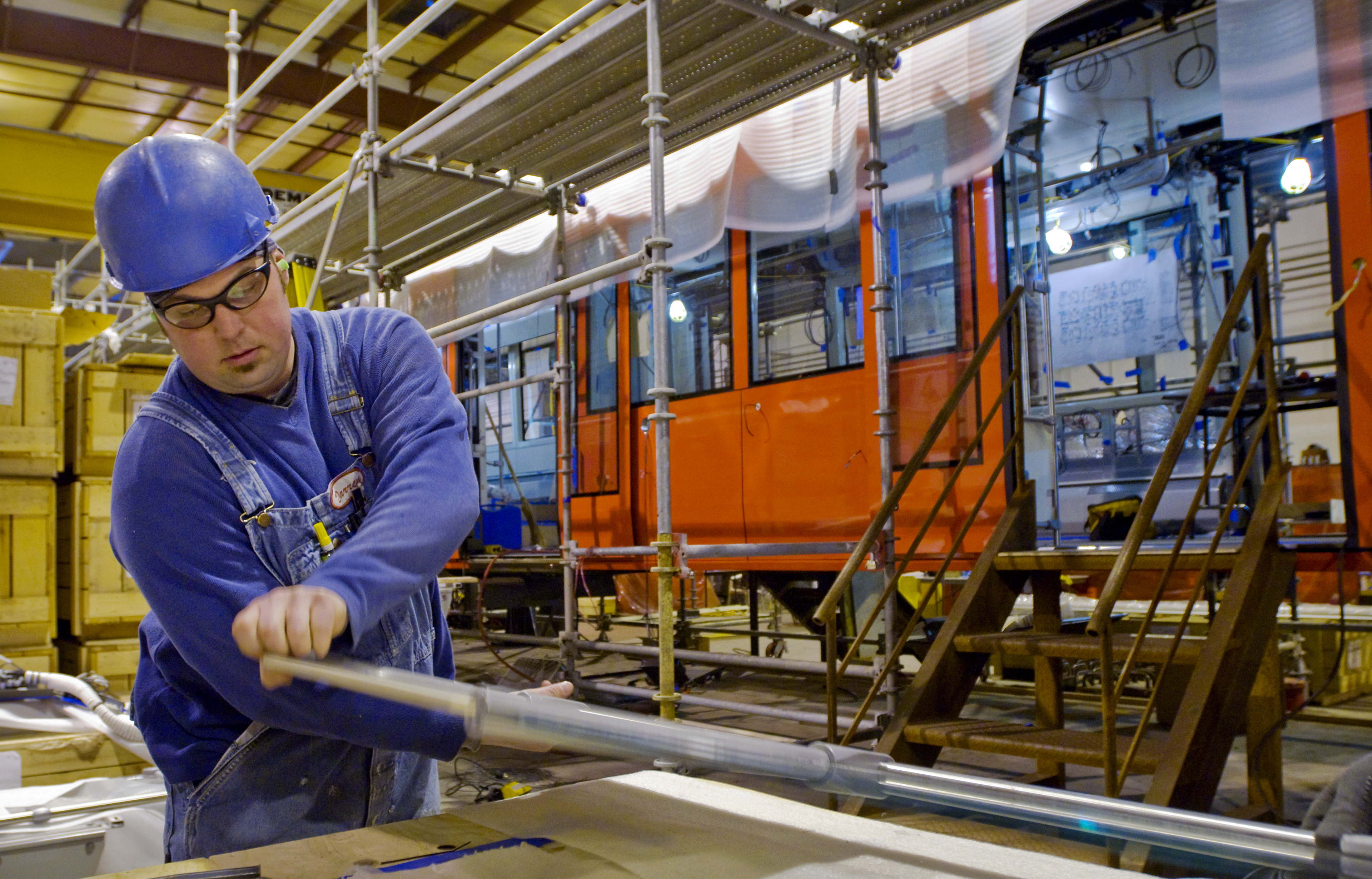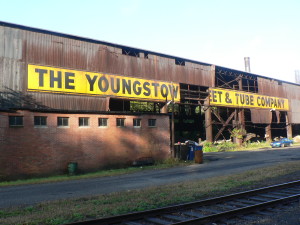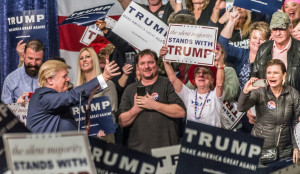Living in the Past: The Truth about the Future of U.S. Manufacturing Jobs
 Darren Delozier (cq), Oregon City works on a partition wall for the articulated electric streetcar being made, for use in Portland, by Oregon Iron Works in Clackamas. The streetcar should be completed later this spring.
Darren Delozier (cq), Oregon City works on a partition wall for the articulated electric streetcar being made, for use in Portland, by Oregon Iron Works in Clackamas. The streetcar should be completed later this spring.
As the news media reported on the results of the United States presidential election last Tuesday night, the biggest surprise came from the Rust Belt states. Iowa, Michigan, Ohio, Pennsylvania and Wisconsin all voted in favour of Republican President-elect Donald Trump. Pennsylvania and Michigan had not voted for a Republican in a presidential election since 1988, Wisconsin since 1984. While urban centres like Wayne County (Detroit), Philadelphia County (Philadelphia), and Milwaukee County (Milwaukee) all voted overwhelmingly Democratic, it was the smaller, blue-collar factory towns that gave Donald Trump the boost needed to win the Electoral College. Why was it that towns such as Scranton, Pennsylvania, Youngstown, Ohio and Grand Rapids, Michigan, all traditional Democratic-leaning towns, voted in larger numbers for Trump? The simple answer is that Donald Trump stated and insinuated throughout his campaign that he would be the saviour of blue-collar manufacturing jobs. However, Trump’s rhetoric of creating manufacturing jobs for low-skilled and semi-skilled workers will be difficult, if not impossible, to turn into reality.

Once upon a time, manufacturing jobs played a vital role in the American economy. The rise of the manufacturing sector took place following World War II, as the U.S. took control from the dilapidated European markets. The growth in manufacturing helped to give rise to an American working class in which high-school educated factory workers made an honest living that allowed them to provide for a family in a rural area. The image of the American factory worker is since connected to the rise of the United States as the 20th century global superpower. By 1979, over 19 million Americans were working in the manufacturing sector. Just as the rise of the manufacturing industry put a spotlight on the strength of the factory worker, its decline presented an image of the factory worker who lagged behind and could no longer support a family. Manufacturing jobs have been on this steady decline since the early 1990s; more than 5.5 million jobs have been lost over the past 25 years. This statistic has hit home predominantly in the Rust Belt, where the decline of the factory work has meant an increase in poverty and the destruction of once booming working class communities. The anger and frustration experienced by these communities is understandable, but an economic solution is not so simple.
Cue Donald Trump; the real-estate mogul and reality TV star who, as a tool of his campaign, played into the anger of the rural blue-collar worker and promised to bring back manufacturing jobs to rural America. Although he did not present a comprehensive plan on how this would be achieved, he has assured that American companies would no longer go abroad for cheaper labour and that he would repeal NAFTA in order to bring back manufacturing jobs. As invoked through his now notorious campaign slogan, Trump wants to turn back the clocks to 1970 and make manufacturing an integral part of the American economy. The sad reality, which may seem more obvious than not, is that we cannot go back to our 1979 economy, no matter how strongly Trump wants blue-collar workers to believe that we can. Changes in technology, production and the global supply chain all present large obstacles in reviving the once booming American manufacturing sector.

Advances in technology is not the scapegoat factory workers want to hear when discussing why there are less manufacturing jobs. However, it is probably the most evident reason as for why manufacturing jobs are not returning to the United States at a fast enough pace. Advances in technology over the past two decades have allowed for an increase in manufacturing output that does not reflect an increase in manufacturing jobs. FiveThirtyEight reports that since the recession of 2009, there have been gains in both American manufacturing output and employment, but not on an equal level. Since 2009, manufacturing output has increased nearly 20% in the United States with a positive percent change of only 5% in employment. The reason is due in large part to the obsolescence of the low-skilled worker within the manufacturing sector. As output is increasing, so is the automation of the industry. Advances in automation technology has rendered the low-skilled job, once at the heart of manufacturing employment, obsolete. In addition, low-skilled jobs that have not been taken over by automation are often outsourced by companies in an attempt to decrease labour costs and remain competitive. While there is a dramatic need for employment opportunities to revitalize blue-collar towns, the high school educated employment seeker will no longer find a good paying job in a factory as automation has taken over. Not even Donald Trump can fight back against technological progression in his vision of a reminiscent America.
On the campaign trail, manufacturing job loss paired with the rise of China, Mexico and other foreign states was a strong talking point and a rallying cry for the white working class. Most economists do agree that the rise of market-economies with cheap labour in Asia and Latin American has had a harmful impact on America’s manufacturing sector. Since 1999, the U.S. has lost more than one million manufacturing jobs to China. There has also been no shortage of U.S. car manufacturers moving to Mexico looking to extend profits. Both Ford and Chrysler Automobiles moved large manufacturing plants to Mexico in the past year. The reality must set in that manufacturing companies will not be rushing back to the U.S. for labour as long countries like China and Mexico are open for business. To counteract American job loss to foreign states, Trump has insinuated that higher tariffs on goods coming from abroad will force U.S. manufacturers to stay within the country. However, evidence on increased tariffs does little to prove this point. Firstly, according to World Trade Organization rules (which Trump has also threatened to pull out of), a president does not have the authority to impose punitive tariffs that target one country in specific, as Trump has stated he would do with Mexico. Secondly, increased tariffs would ultimately cost the average American household an extra 4% of their after-tax income. American domestic livelihood would be dramatically effected by such an outcome, especially lower income voters who helped to elect Trump under the belief that he would be the savior of their economies woes.
Donald Trump’s success in Michigan, Pennsylvania and Michigan can largely be attributed to his promise to bring back manufacturing jobs. This promise, one of the cornerstones of his campaigns, is not only a fantasy, but gives a cruel, false sense of hope for struggling blue-collar Americans. The sad reality is that North American economies can no longer support the dream of all hard-working high school graduates landing a good paying factory job. The rise of automated technologies and cheaper labour in foreign markets have ultimately made the majority of low-skilled jobs obsolete. Instead of living in the past, President-elect Donald Trump must work with congress to provide better training so that low-skilled workers can find employment in the technologically advanced manufacturing sector, a sector which has seen growth in the last decade. In order to realistically keep his promise of bringing back manufacturing jobs on a large scale to help struggling blue-collar towns, Trump must also look to further expand the clean energy sector, which has seen tremendous job growth in the past five years. If Donald Trump truly wants to make America great again, it cannot entail living in a 1970s themed fantasyland. It must use the values that made America great, and adapt them to the realities of the present.
